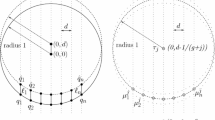Abstract
We study broadcasting time in radio networks, modeled as unit disk graphs (UDG). Emek et al. showed that broadcasting time depends on two parameters of the UDG network, namely, its diameter D (in hops) and its granularity g. The latter is the inverse of the density d of the network which is the minimum Euclidean distance between any two stations. They proved that the minimum broadcasting time is \( \Theta \left( \min\left\{ D + g^2, D \log{g} \right\} \right) \), assuming that each node knows the density of the network and knows exactly its own position in the plane.
In many situations these assumptions are unrealistic. Does removing them influence broadcasting time? The aim of this paper is to answer this question, hence we assume that density is unknown and nodes perceive their position with some unknown error margin ε. It turns out that this combination of missing and inaccurate information substantially changes the problem: the main new challenge becomes fast broadcasting in sparse networks (with constant density), when optimal time is O(D). Nevertheless, under our very weak scenario, we construct a broadcasting algorithm that maintains optimal time \( O \left( \min\left\{ D + g^2, D \log{g} \right\}\right)\) for all networks with at least 2 nodes, of diameter D and granularity g, if each node perceives its position with error margin ε = αd, for any (unknown) constant α< 1/2. Rather surprisingly, the minimum time of an algorithm stopping if the source is alone, turns out to be Θ(D + g 2). Thus, the mere stopping requirement for the special case of the lonely source causes an exponential increase in broadcasting time, for networks of any density and any small diameter. Finally, broadcasting is impossible if ε ≥ d/2.
Access this chapter
Tax calculation will be finalised at checkout
Purchases are for personal use only
Preview
Unable to display preview. Download preview PDF.
Similar content being viewed by others
References
Emek, Y., Gasieniec, L., Kantor, E., Pelc, A., Peleg, D., Su, C.: Broadcasting in UDG radio networks with unknown topology. In: PODC, pp. 195–204 (2007)
Chlebus, B.S., Gasieniec, L., Gibbons, A., Pelc, A., Rytter, W.: Deterministic broadcasting in ad hoc radio networks. Dist. Computing 15(1), 27–38 (2002)
Chlamtac, I., Kutten, S.: On broadcasting in radio networks - problem analysis and protocol design. IEEE Trans. on Communications 33, 1240–1246 (1985)
Chlamtac, I., Weinstein, O.: The wave expansion approach to broadcasting in multihop radio networks. IEEE Trans. on Communications 39, 426–433 (1991)
Gaber, I., Mansour, Y.: Centralized broadcast in multihop radio networks. J. Algorithms 46(1), 1–20 (2003)
Elkin, M., Kortsarz, G.: Improved schedule for radio broadcast. In: SODA, pp. 222–231 (2005)
Gasieniec, L., Peleg, D., Xin, Q.: Faster communication in known topology radio networks. In: PODC, pp. 129–137 (2005)
Kowalski, D.R., Pelc, A.: Optimal deterministic broadcasting in known topology radio networks. Dist. Computing 19(3), 185–195 (2007)
Alon, N., Bar-Noy, A., Linial, N., Peleg, D.: A lower bound for radio broadcast. J. Comput. Syst. Sci. 43(2), 290–298 (1991)
Bar-Yehuda, R., Goldreich, O., Itai, A.: On the time-complexity of broadcast in multi-hop radio networks: An exponential gap between determinism and randomization. J. Comput. Syst. Sci. 45(1), 104–126 (1992)
Bruschi, D., Pinto, M.D.: Lower bounds for the broadcast problem in mobile radio networks. Distrib. Comput. 10(3), 129–135 (1997)
Chlebus, B.S., Gasieniec, L., Östlin, A., Robson, J.M.: Deterministic radio broadcasting. In: ICALP, pp. 717–728 (2000)
Chrobak, M., Gasieniec, L., Rytter, W.: Fast broadcasting and gossiping in radio networks. In: FOCS, pp. 575–581 (2000)
Clementi, A.E.F., Monti, A., Silvestri, R.: Selective families, superimposed codes, and broadcasting on unknown radio networks. In: SODA, pp. 709–718 (2001)
Czumaj, A., Rytter, W.: Broadcasting algorithms in radio networks with unknown topology. In: FOCS, pp. 492–501 (2003)
Kowalski, D.R., Pelc, A.: Time complexity of radio broadcasting: adaptiveness vs. obliviousness and randomization vs. determinism. Theor. Comput. Sci. 333(3), 355–371 (2005)
Marco, G.D.: Distributed broadcast in unknown radio networks. In: SODA, pp. 208–217 (2008)
Kushilevitz, E., Mansour, Y.: An omega( log (/d)) lower bound for broadcast in radio networks. SIAM J. Comput. 27(3), 702–712 (1998)
Dessmark, A., Pelc, A.: Broadcasting in geometric radio networks. J. Discrete Algorithms 5(1), 187–201 (2007)
Diks, K., Kranakis, E., Krizanc, D., Pelc, A.: The impact of information on broadcasting time in linear radio networks. Theor. Comput. Sci. 287(2), 449–471 (2002)
Sen, A., Huson, M.L.: A new model for scheduling packet radio networks. In: INFOCOM, pp. 1116–1124 (1996)
Moscibroda, T., Wattenhofer, R.: Maximal independent sets in radio networks. In: PODC, pp. 148–157 (2005)
Moscibroda, T., Wattenhofer, R.: Coloring unstructured radio networks. In: SPAA, pp. 39–48 (2005)
Kowalski, D.R., Pelc, A.: Time of deterministic broadcasting in radio networks with local knowledge. SIAM J. Comput. 33(4), 870–891 (2004)
Author information
Authors and Affiliations
Editor information
Rights and permissions
Copyright information
© 2008 Springer-Verlag Berlin Heidelberg
About this paper
Cite this paper
Fusco, E.G., Pelc, A. (2008). Broadcasting in UDG Radio Networks with Missing and Inaccurate Information. In: Taubenfeld, G. (eds) Distributed Computing. DISC 2008. Lecture Notes in Computer Science, vol 5218. Springer, Berlin, Heidelberg. https://doi.org/10.1007/978-3-540-87779-0_18
Download citation
DOI: https://doi.org/10.1007/978-3-540-87779-0_18
Publisher Name: Springer, Berlin, Heidelberg
Print ISBN: 978-3-540-87778-3
Online ISBN: 978-3-540-87779-0
eBook Packages: Computer ScienceComputer Science (R0)




